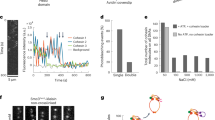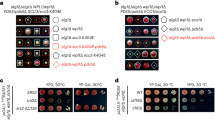Abstract
Sister chromatid cohesion, which is essential for mitosis, is mediated by a multi-subunit protein complex called cohesin. Cohesin’s Scc1, Smc1 and Smc3 subunits form a tripartite ring structure, and it has been proposed that cohesin holds sister DNA molecules together by trapping them inside its ring. To test this, we used site-specific crosslinking to create chemical connections at the three interfaces between the three constituent polypeptides of the ring, thereby creating covalently closed cohesin rings. As predicted by the ring entrapment model, this procedure produced dimeric DNA–cohesin structures that are resistant to protein denaturation. We conclude that cohesin rings concatenate individual sister minichromosome DNA molecules.
This is a preview of subscription content, access via your institution
Access options
Subscribe to this journal
Receive 51 print issues and online access
$199.00 per year
only $3.90 per issue
Buy this article
- Purchase on Springer Link
- Instant access to full article PDF
Prices may be subject to local taxes which are calculated during checkout




Similar content being viewed by others
References
Nasmyth, K. & Haering, C. H. The structure and function of SMC and kleisin complexes. Annu. Rev. Biochem. 74, 595–648 (2005)
Hirano, T. SMC proteins and chromosome mechanics: from bacteria to humans. Phil. Trans. R. Soc. B 360, 507–514 (2005)
Uhlmann, F. et al. Cleavage of cohesin by the CD clan protease separin triggers anaphase in yeast. Cell 103, 375–386 (2000)
Haering, C. H., Lowe, J., Hochwagen, A. & Nasmyth, K. Molecular architecture of SMC proteins and the yeast cohesin complex. Mol. Cell 9, 773–788 (2002)
Hirano, M. & Hirano, T. Hinge-mediated dimerization of SMC protein is essential for its dynamic interaction with DNA. EMBO J. 21, 5733–5744 (2002)
Gruber, S., Haering, C. H. & Nasmyth, K. Chromosomal cohesin forms a ring. Cell 112, 765–777 (2003)
Ivanov, D. & Nasmyth, K. A physical assay for sister chromatid cohesion in vitro . Mol. Cell 27, 300–310 (2007)
Milutinovich, M. & Koshland, D. E. Molecular biology. SMC complexes–wrapped up in controversy. Science 300, 1101–1102 (2003)
Kim, J. S. & Raines, R. T. Dibromobimane as a fluorescent crosslinking reagent. Anal. Biochem. 225, 174–176 (1995)
Dhar, G., Sanders, E. R. & Johnson, R. C. Architecture of the hin synaptic complex during recombination: the recombinase subunits translocate with the DNA strands. Cell 119, 33–45 (2004)
Eswar, N. et al. Comparative protein structure modeling using Modeller. Curr. Protoc. Bioinformatics Supplement 15 5.6.1–5.6.30 doi: 10.1002/0471250953.bi0506s15 (2006)
Haering, C. H. et al. Structure and stability of cohesin’s Smc1-kleisin interaction. Mol. Cell 15, 951–964 (2004)
Gruber, S. et al. Evidence that loading of cohesin onto chromosomes involves opening of its SMC hinge. Cell 127, 523–537 (2006)
Bausch, C. et al. Transcription alters chromosomal locations of cohesin in Saccharomyces cerevisiae . Mol. Cell. Biol. 27, 8522–8532 (2007)
Schuldiner, O. et al. piggyBac-based mosaic screen identifies a postmitotic function for cohesin in regulating developmental axon pruning. Dev. Cell 14, 227–238 (2008)
Pauli, A. et al. Cell-type-specific TEV protease cleavage reveals cohesin functions in Drosophila neurons. Dev. Cell 14, 239–251 (2008)
Hwang, D. C. et al. Characterization of active-site residues of the NIa protease from tobacco vein mottling virus. Mol. Cell 10, 505–511 (2000)
Acknowledgements
We thank S. Gruber for help with the design of cysteine mutations, and P. Fowler, D. Ivanov, V. Katis and all members of the Nasmyth laboratory for advice and discussions. This work was supported by the Medical Research Council, the Wellcome Trust and Cancer Research UK.
Author information
Authors and Affiliations
Corresponding author
Supplementary information
Supplementary Information
The file contains Supplementary Results, Supplementary Table 1 and Supplementary Figures 1-7 with Legends. (PDF 2444 kb)
Rights and permissions
About this article
Cite this article
Haering, C., Farcas, AM., Arumugam, P. et al. The cohesin ring concatenates sister DNA molecules. Nature 454, 297–301 (2008). https://doi.org/10.1038/nature07098
Received:
Accepted:
Published:
Issue Date:
DOI: https://doi.org/10.1038/nature07098
This article is cited by
-
Mechanical disengagement of the cohesin ring
Nature Structural & Molecular Biology (2024)
-
Coordination of cohesin and DNA replication observed with purified proteins
Nature (2024)
-
Genome control by SMC complexes
Nature Reviews Molecular Cell Biology (2023)
-
Single cohesin molecules generate force by two distinct mechanisms
Nature Communications (2023)
-
Loss of cohesin regulator PDS5A reveals repressive role of Polycomb loops
Nature Communications (2023)
Comments
By submitting a comment you agree to abide by our Terms and Community Guidelines. If you find something abusive or that does not comply with our terms or guidelines please flag it as inappropriate.



